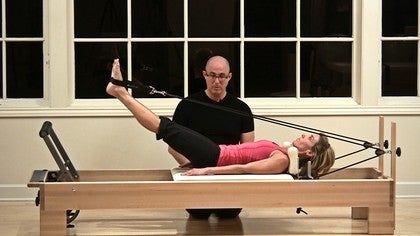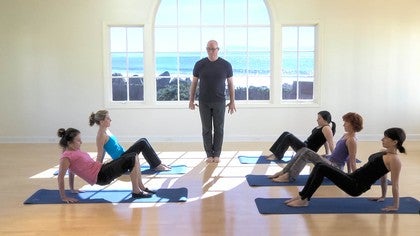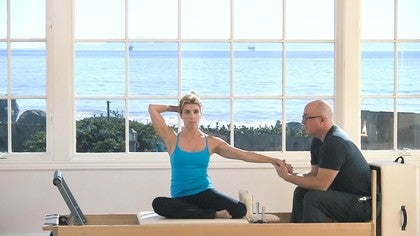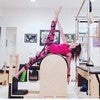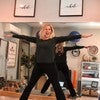Description
About This Video
Transcript
Read Full Transcript
All right, so what I'd like to do today is basically introduce a reformer class with Kristi, and have the focus on somebody who's coming to us with mechanical low back pain. Somebody who typically has spasms in their low back, they have some difficulty moving around, pain with bending. We're going to try to do a class in 30, 40 minutes with Kristi to try to give you some mobility. And basically, to inhibit some of the big global stabilizers, as we talked about earlier. And also to wake up the stabilizing muscles, the low deep muscles.
And try to do that in the context of a fluid, full, reformer class. So we will start with footwork. I'm going to have you on your back. And I have, right now, two reds and a blue spring set for you. And I'd like to start just like that-- on your heels nice and easy.
That looks great. And just give me three or four repetitions, and them I'm going to have you stay out. And while you're staying out here on this one, think of the space that gravity provides for you. So just take a deep breath and allow the back of the neck to drop down as you exhale, the shoulders widen, and the lumber actually gets a little bit longer. So we want to avoid the concept of tucking or pulling the back down.
And rather than doing that, is letting this soften down. And relax this a little bit-- there you go-- so now I have a little more length. You feel that? So now we let the knees bend down, bring in the carriage back home. And repeat.
And let's go ahead and do about 10 repetitions there. A lot of times what we tend to do is, we want to get that space to decrease a little bit of the gravity, we end up posteriorly tilting the back, instead of letting the ribs open and relaxed down. So what we're trying to concentrate on is to let that back just relax. Let it lengthen as you press out with your legs. And on this next one, let's bring you feet together.
And same thing. Just reaching out nice and long, feel that length. And again, we're using as much as necessary, as little as possible. So we're just moving fluidly through it. And the image I like is like a bicycle, there's really no start or stop to it when you're peddling.
And that's what I want you to feel here. You're just a continuous-- you get to that tallest point and you come back down. And let's add a little bit of rotation, and just keep the rhythm going. And again, here now, you can feel a little bit of the-- allowing the knees to go out to the side, which allows the hip to drop into the socket. So when you bend down, the hip's coming in.
You drop down, hip's dropping in. Think more of the bone gliding and moving, and allowing that-- we call it disassociation in the hip. So get rid of the muscles and just think of the skeleton moving. The springs are acting like your muscles. And one more time.
And then let's take it out nice and wide. Now from here, we're going to think more of sit bones. So press out and the sit bones actually come together. Drop down, the sit bones widen. So initially-- yes, yes, yes.
And that also creates that release that I want you to feel. Rather that thinking of pulling down or pushing up, just do the movement from the pelvic floor. And really think of the bones moving, rather than even the muscles moving. And that looks great. And then from there, we're just going to go right into some gentle circles.
So you're going to stay out wide and press out, and then let the knees come in to come in. So we get a nice little massage in the hips. Just get familiar with it. And what should happen, because the femur is ball and socket, there shouldn't be any stop. So the stops are going to be muscle induced.
So just allow-- that's right. You feel how you just let go of that? Perfect. So here with a low back problem, we're trying to get rid-- I don't want you to use muscles. You're using too many muscles already.
You're guarded up. We don't know where to move from. And now we're going to learn, oh I can move my hips, and I can get a lot of freedom from my hips and let my back rest. Reverse the direction. That's it.
Even if it feels a little odd, it's-- Am I coming together? Uh-huh. OK. Because internal rotation is going to stretch and open up the back of the pelvis and the hip. And that's where when you get the butt squeezing together to protect your back, we actually do more damage to our back.
Let's do that one more time. And relax. So let's come with the together here and press out. Stay out this time and let your heels come down towards me. And I want you to use the image of the fascia of your whole back is like a hammock between two coconut trees.
I'm one of those coconut trees. And somebody else is pulling on the back of the head. So you just feel that. Now take in a deep breath-- expand, expand, expand-- belly too. Let everything expand.
Yes. And as you exhale, everything drops into the hammock. Don't force it, let it drop. One more time-- deep breath. There you go.
Let it just drop into the hammock. Now bringing the carriage back home, you're going to initiate the knees. Let the knees bend up towards the ceiling and bring the carriage home. There it is. And initiate the carriage going out by pushing your heels in my hand.
Yes, that's it. Good. Bend the knees to come down, press the heels to go out. So now what we're doing is we're disassociated that idea of, I have to push on my toes to push out with my legs, right? Really feel that sink underneath.
So we're tightening that fabric every time it comes down, and then loosening it. And tighten. Yes. And the same thing here. Yes.
And stay out this time. And again, just-- feel that open up. Good. OK. So now rise up onto those toes, keep the heels up, and bend the knees down.
Bend the hip. So now we're challenging a little bit the same thing we just learned. So without having to push anything down or anything, just feel that length that opened the fascia, and just now challenging through the ankles and the knees. And let's just do eight of those now to give you some nice strength work as well. So our goal is to hit all of the muscle groups through the lower leg in a way that they all should be warming up-- all the joints.
We've gone plantarflexion, dorsiflexion, circumduction of the hip, internal, external rotation, flexion extension of the knee. So we've hit all of those now in about three minutes. And now ready to move on to some bridging. So we're going to bring the feet-- and let's go out wide, drop your head rest down. Make sure your head rest is down before you go into the bridge.
And what I want to do first is actually tilt anteriorly. And then come back into your bridge. Yep. Very nice. Now stop there.
And give me a little bit of a reach through there. Yep, now take in a deep breath. Let the sternum sink down, and now bring each vertebrae down. Remember we talked about the ribs. So the ribs are going to go posterior and up underneath you as you drop down.
Yeah. Yeah. So that gave us a nice movement immediately up in your thoracic. And don't worry about a whole lot of tilting down the low back for you. Right?
Again, we're focusing on low back pain, so we want to make sure that we don't do too much there. Right? So then the ribs are going to come forward and down. So we never feel the ribs jumping out. Take in a deep breath.
Now the ribs are coming down and up. Yes. Yes. Very nice. So this time we're going to come up and we're going to do what I call the typewriter.
So you have to be a vintage age to understand what a typewriter is. Have you ever seen a typewriter before? Yeah. OK. So roll up.
Good. Stop right there. So what I want to do is I want to wake up the local stabilizes little bit. And we're just going to laterally translate to the right and to the left. Yep.
And try not to tilt with it because all we want to do is just slide. There you go. Feel how we want to rotate around that area? I want you to slide through it. Follow my hand, It's just sort of a foreign area to translate like-- there you go! There you go.
Now you're finding it. So use less. Good. Now drop down a centimeter right here and do the same thing again. Careful of the the drop down.
That's the typewriter. Running right on that-- there it is. Then dropping down another centimeter. Same thing. Slide.
Then slide. Careful not to drop. Yeah, I've got no idea-- Right? It's good though. Keep going because this what we want.
This is how we wake up those local stabilizers. So when she sliding back and forth, side to side, the local stabilizers or waking up and the globals have to let go. If the globals are on, they pull her into rotation. And you can sort of see that rotation happening. That's it.
And drop down. Now you're going to notice a big difference when you roll up this time. So do the regular bridge again. And no effort. Just let it-- it's just going to come up.
You see that? Yeah, I don't know what happened but I felt it. Yeah, just sort of just peeled up without any muscles. You didn't have to use a lot of glutes or hamstrings. So let's do that one more time.
So drop down an inch, slide side to side. And just keep practicing until you feel almost like you're on a skateboard that's rolling back and forth. Yes. Drop down an inch. Same thing.
So if you can get five segments to slide back and forth, that's like 150% more movement than most people have anyway. Healthy people strategizing only from L4-L5, L5-S1. That's the area you need to work. That's probably quadratus is compensating there. Wake up those locals.
So now we're going to try a little different thing here. So you're going to roll up. Sit up? Nope, you're going to roll up in a bridge, sorry. And I'm going to block this area here.
So you're going to roll down normal and you're going to let that left side drop down. Keep going. Keep going. Keep going. Let it drop down.
Now bring it back up segmentally from the sit bone. There it is. And up. Good. Do that again.
Can I rotate them? Yeah, yeah, yeah. This one I want you to rotate. So we're opening that side up and it drops down. Yes.
Bring that left sit bone up to me first. And then keep coming up. Segment. Yes, there you go. I hate to turn my back to the camera, but we're going to the same thing on the other side.
The camera can maybe pick up a little bit. The same thing, rolling down. wake it up. Uncle! I can't move. And roll back up, you're doing fine.
So maybe it's more the right side that's restricted and the left side that moves too much. The left side's a little painful. But it'd be the same for anybody. Let that right hip drop down. There it goes.
Bring that sit bone back up towards me. That's it. OK. Now go back to your translation one more time. See if it's a little easier.
Right there. Beautiful. OK. So again, very important exercise. Take your time.
Segmentally move side to side, work your way. If you can get five segments sliding back and forth, that's great. It's hard to block without a friend to help you block the rotation. But the side to side often is significant. Does that feel better?
So now, give me just one more bridge up and down, nice and easy. And just feel yourself float up. Beautiful, see, you picked up three or four more segments of movement. So the idea is you flexion is going to be much easier and we got rid of the guarding muscles in your low back. So now we're going to challenge that control a little bit.
I'm going to drop you down to red and a blue spring. If you want your headrest up, you can put it back up again. We're going feet in straps. Straighten the legs out. You're OK with the headrest down?
It's up to you. Let's stay parallel, because remember, when we do it turned out, what we end up doing is we're over recruiting the rotators. And right now we're trying to say, let's get those hips sockets to drop in. So here, our visually image, again, here's the socket. Here's the femur.
The femur is going to be rolling down and back-- this way, the head. And the pelvis will be going the opposite direction. So as this goes down, the pelvis actually goes a little bit anterior. And what it should look like is the pelvis doesn't move at all. So it's almost like you're just allowing the femur to slide back.
OK? So let's give that a try. And down. Yup. And down.
And I'm much more interested with low back pain in the coming up than the going down-- in the acute low back pain. When we start progressing, I want to challenge more. I'm going to take you down lower and lower the challenge the anterior connection between the ribcage and pelvis. So if you want to, you can use your breath, and you can increase a little bit in both directions as long as you can keep that pelvis nice and quiet. That looks great.
There you go. Nice. It's just like a sinusoidal contraction of the anterior and posterior muscles. So when the legs are going up, the back muscles start to contract. And you come down about 45-- stop there and nothing's working.
Right so that's that middle, right? The springs are doing the work. OK? So now what I want you to do is actually turn your feet in towards each other. And do the same thing now and see if you can-- you won't go as high.
There you go. Yep. And just be aware of that. A little odd, right? You see how the ballerinas respond to this is even worse.
OK, good. Now go ahead and bring it into the parallel at 45. OK. Drop it down about 10, 15 more degrees. Stay there.
And now just open and close the legs from there. And close. Now be careful of this position. So as you open, those femurs are rolling in this way. Yes.
You just corrected a torsion there. And back. And in. There it is. Let's see if we can get rid of that snapping hip.
So go about half as far. And go a little bit of internal rotation. Let is sink. That's as far as you're going to go. And bring it in.
So we don't need to be going out further than that. Are you a magician too? Uh-huh. That's it. That's what I want right there.
And let's just do a little bit of bending the knees in with the straps floating on top of the shins. And only as far as you can keep it quiet. Good and again. So what we're going to do here is use your own proprioception to be aware of it by separating the legs about 10 inches. And now close your eyes.
Press the legs out and be really observant. So you're going to feel, when you close your eyes, you're going to feel the asymmetry between the legs. Almost everybody has it. One leg bends before the other. One lengthens before the other.
Just closing your eyes and allowing the legs to move, and recognize it, and then correct it from the inside. You correct your own torsion. You correct your own leg length discrepancy, you correct that instability in the pelvis. Because the organizations inside of you and you can do it. Let's do two more of those.
It's looking really good. Things are waking up. I like that. And last one. OK?
So open your eyes. Bring you knees in. You're just going to slip you hands right into those loops and leave your legs at 90 degrees-- sort of the table top position. And I'm going to take you down to one red right now. So here let's go ahead and just do some simple arm arcs-- bringing the hands down towards the hips.
And I want you to notice the pressure of the shoulders wanting to come up when you push down. So we're only going to go to where we get that optimal congruency in the shoulder. So it's going to be about right there. If you come down too far, that shoulder starts to pop up. And you actually have a really good range of motion, Kristi.
Most people, when they go down that far, that shoulder's going to jump up. Very important that we don't let it go down that far, because then we're going to lose the orientation. So now, arms up and down. And I want you to think of the arms being drawn down by the ribs. So this is drawing the-- yes.
Good. Find that connection and then it's almost no work it all for the arms. Can you see that? Good. Now from here, we're going to prepare ourselves.
We're not going to do Hundred, but we're going to do a preparation for it. So we're going to bring the arms down. And think of those ribs. Remember, they're going to go back and up underneath as you bring your head and shoulders up. That's it.
And then go back down. Arc the arms up, draw the arms down with the ribs. And then as you roll up, the ribs are going to come underneath. Yes. Yes.
Did you see how easy that was? And why your heads just really relaxed there? Exactly what we want. Let's do four more those so we are getting some-- exactly. So you see, we're not going down on the lumbar at all.
Can you tell that? So when the ribs move the right way, the lumbar can chill. And you get that nice roll up without feeling like you've got to tilt, or posteriorly squeeze the but together, or anything like that. You got two more of those in you, right? I like that.
Yep. Good. Last one. Stay there. Bend the elbows.
Let's do just a little coordination. I'm going to take the way of the legs. So reach the legs into me and let's just do a straight one. Just bend both back at the same time. Yeah, we'll do a basic-- and back in.
And now I'll add the coordination to it. So go ahead and bring knees in. And elbows. And we'll do two of those. Reach both out, and bring knees in, and elbows.
This looks great. Last one. And knees and elbows, and relax. Good. All right.
Straighten you legs out over the bar. And reach your hands up towards the ceiling. And I'm just going to help you peel up. And again, thinking of those ribs coming underneath you, and rolling ourselves up into the position. Good.
OK. Bring the lets down. So I want to go quadruped position-- so hands and knees. Now I'm going to start you on a-- now let's see. Do I want this down?
There we go. So hands on the frame. And I'm actually going to take you down to a blue. So we're going to use a blue spring. And I think I want you just straight up and down on those arms or legs.
That looks good. And let's think of a crown reaching tailbone reaching. And let's go ahead and just take the legs out. So push them straight up. And back in.
Now I expect-- a lot of times people think that the that bottom shouldn't drop down, so they try to get their bottom still. And the bottom has to drop down if you're going to open up the hips. And bring it back in. The key is to keep the ribs in the hips connected. Yes.
There it is. So it's very dynamic. As the knees come in, the ribs have to come up. There it is. You feel that?
OK, now stay there. And push out with the arms just a little bit. Now remember, we're feeling that connection. Here. Good.
And back in. And it's all about connection. So it's not really recruiting muscle. It's just where that stiffness comes from. That looks great.
Give me two more of those. And come back in. Now let's convert that right into a knee stretch. So I'm going to bring it up. Did I do that wrong?
OK. And let's add a red spring on that. OK. So hand here. And let's stay flatback for today.
But let's work on the accents. So what I want to feel is the knees able to come in and accent on the exhalation. And really focus on that challenge here. So it's as if you're stepping off a curb. If you're going up steps.
Getting in and out of your car. Dropping a kid-- got to pick a kid up, something like that-- drop groceries. Those are the quick responses that often hurt us. So if you can feel a little bit preparation for the quick response-- that's it. That's it.
And in. And in. And in. And in. And in.
And in this, even in the low back here, class, I don't mind challenging people. So if I wanted you to take your knees off, I felt you were strong enough and still challenging-- keep this area to do-- let your knees come off two inches. And let it come down. Perfect. OK.
So from here, let's go right into an elephant position. And again, we'll start with a little bit more of a neutral. So even if you had to bend your knees, let the heels come up a little bit. It's fine. And we'll go into a roundback.
So we'll start introducing round back in the spine. So from there, pressing the legs out. And I'm going to give you the resistance to pull in. So pull in against my foot. That's it.
And out. And pull in. Pull, pull, pull, pull, pull. That's it. And pull again.
Now be careful of the hip flexors pulling the spine forward. So the ribs are going to draw up underneath. There it is. There it is. There it is.
That's what I'm looking for. You feel the difference? Give me two more there, and then we'll go into a roundback. Pull against my foot and let's go round back. And keep going.
Create your own resistance. And feel the roundness here, and a little bit less here. So we're still flexed, but we're opened. Yeah. That's exactly we're looking for.
Good. Nice. OK. Let's go into a couple planks. So you're going to let your heels come up.
And we'll do four planks and four jackrabbits. So we'll keep it pretty simple. So let the hips come up. And down. And when you go out, you're going to feel that-- yes.
There it is. So this can be a little bit more relaxed. There. You see how you don't need that. OK, now hinge up.
So we're going to use half as much, but keep the same alignment. So it's that suspension between the pubic bone and you're going to come up to your sternum. Just like feet in straps. Think feet in straps upside down. There you go.
There you go. That's much better. Two more of those. And let's stay down on this next one. And just give me four jackrabbits.
So knees come in. That's a jackrabbit right there. Yup. Keep this connected. So now it's just like we were doing with the feet in straps, right?
Everything's the same. It's just we're now going into that stage three, where we're challenging the same things we did before. And relax. Come down on your knees. And let's introduce a little bit of extension.
So a down stretch. So hips are going to come forward. Opening up with the hips. Yep, that's plenty. And we're going to make it a little bit lighter.
And just press out with the arms. And come up. That's it. Yep. Good.
And down. And up. So remember what the ribs are doing. The ribs are going to be going forward and down. Yep.
Yep. Yep. That's it, right there. Good. Good.
Good. And when you're coming in, it's just like the arm marks that we're connecting now. Yes. So you feel the arm marks drawing down. The ribs are coming forward and down.
Everything's connected. And now you can do the same thing with a lot less energy. Body's just in its natural position. I like that. Let's do one more of those.
We're going to introduce our first rotation. OK. So we're going to bring both hands over to the left. Yup. Let it rotate a little bit.
And we're actually going from right knee to left shoulder. That's your rotation. OK. So pressing out. And I want to feel, as you're pushing down, this pushing down is going to facilitate that rotations.
It's like, this pushes, this pulls. And back. Lift, lift, lift, with it. There it is. And lift.
There it is. Yep. Yep. Yep. One more time.
So we can teach a rotation without compression in that low back. That's what we're trying to fill. The lats hook into that thoracolumbar fascia. So when you push down on that bar, you're actually lifting, and actually elongating the low back. Ribs coming forward and down.
Keep the connection in front. Let's a switch sides. That's it. Yep. And again, feel that lift.
There it is. Feel the connection in the back of the arms, front of the ribs. And lift. One more time. And lift.
Excellent. Good. Now I'm going to drop the bar down just one notch. I'm going to have you sit on top of the bar. So the bottom here, feet on here.
And I think I'll go to a red and a blue. So a red and a blue spring. Hook your heels on the edge. Get your bottom so it's wedged between the carriage and the bar. So the sit bones are there.
And this is a beautiful exercise to teach where movement is going to come from. So just do a couple leg presses and see if you can feel that you have enough balance that you could do without your hands. We good? Yeah. OK.
So now take your hands out into a second position here. And as you straighten your legs out, you're going to sweep your body down into flexion. As the knees bend in, we're going to bring chest up to the ceiling. So what has to happen here is you have to use core muscles to some degree to keep your balance. And you have to free up the thoracic in chest to be able to move through space.
To stay nice and elongated, opening up, and sweep down. That's it. Knees bend and open up. And down. So feel a little more extension in that ribcage, when we talked about those ribs.
We're going to go forward and down. Give me the sternum up high. Yep. Good. And circle the arms around.
When it goes forward, the ribs come up underneath. Yes. And up. And down. That's it.
Good. It's not about the range of the motion, it's about that connection. That looks really nice. You've got a nice, beautiful arc in your movement. Exactly.
Exactly. Nice. Feel the extension up high. Yep. There it is.
Last one. And let's add a little rotation to it while I got you. So you're going to come up and lead with this arm. Come into the extension. Knees bend in.
Come here. Open. And spin. And sweep. Lead with the left arm.
Open. Spin and sweep. And down. And up. So we're teaching that thoracic mobility.
That's it. You see how you're not rotating at all here. Because if you rotate in your low back, what's going to happen? I'm going to fall. You're going to fall.
And relax. That's great. Good. Let's finish up a little bit of reverse work. So I'm going to have you go on your hands and knees facing this way.
I'll drop you down to-- you can go with a single blue spring or a single red spring typically. Hands are going to be here. And we're going to make a perfect square. And I want about two or three inches between your knees and the pad. Yep.
From here, without moving the carriage, let's just go forward into a parallelogram-- 'til your thighs hit. Yep. Ribs are going to come up. Right there. Hands stay here.
Thumbs out of the tracks. And not just draw the knees towards the hands. Find those ribs. There it is. It's a little more challenging.
There you go. With this, you have to release these muscles to draw that in. Be very careful of letting the hip flexors dominate. Yes. You got it.
That's it right there. Good. And that's a blue spring. So you get an idea of the challenge in the balance between hip flexors and the anterior wall. Beautiful.
One more time. That's it. And relax. Good. Now just come up into a nice, tall moving position.
Grab your straps. And let's just finish up with a little chest expansion. So I'm going to stay here with my hand just so you don't take a dive. But you're going to bring your hands straight back with an inhalation. And we're going to really feel that expansion.
But I want you to feel expansion back here. So we use that breath all the way around. Exhale looking to the right. To the left. And let the hands come forward.
Continue to exhale and grow. And inhale. Expand into my hands, and look left, and right, and exhale. Hands come forward. And you get rid of that air, you're filling everything up That's it.
Keep blowing it out. No more air, no more air. Inhale. Good. And exhale.
Exhale. Continue to blow it out. Blow it out. Last one. Back here.
And exhale. Now a lot of times, typically we want to push back a little too far. So even think a little bit less. We'll do two more. Think of it coming to the side and feel the air expanding to the back, as well as the front.
The head just sitting on top. Let the hands come here rather than back here. Because this will sort of make you go into a little bit too much extension. And even choke up a little bit on the cables and it will give you a little better feel on that. There you go.
Let's try it. Stop there. Good. And exhale side. Side.
I like that a lot better. Yes. Growth with that exhalation. Challenge yourself. Get right on the edge like you're going to go forward.
I won't let you fall, I promise. There it is. That's a much better connection. Getting out of that little bit of extension you like to put your low back in. And relax.
Good. All right. Let's see. We've got time for one more little thing. We're going to do a little scooter.
We'll do something in weight-bearing. So I'm going to have you stand with your left foot there and your right foot here. And we'll bring you up to a single red to start. And on this one, I want you-- just as we start with it here, I want you to come here and drop down with it as best you can. You might have to lean a little forward, just so you knees clear on it.
But I want to have this leg down as far as you can get it. There we go. So now, again, hip flexors challenging your core. When you push that right leg back, that hip flexor wants your back to do this. Right?
And you're not going to let it. No. It could be a small little stroke. It doesn't have to be a big stroke. That's what I want right there.
So I want you out as vertical as possible in your body. And just a little pulse of a challenge. That's when you're walking-- that hip flexor, when you go into toe off, isn't going to keep pulling your back into an extension and insulting that ligament, or facet that's giving you trouble. That looks fantastic. Do two more there.
And it's a lot more challenging. You're glistening. Makeup? Powder. And switch sides.
And again, that's just with one red spring. So again, a lot of times mostly what we did was use a red or a single blue spring for most of the things. It was really just about are you-- you don't need to put that much stress on the body to figure it out. There you go. That's it.
Yep. Subtle, small range. And it's different side to side, right? You can feel the difference on this side. So only go to where you feel control.
That rib-- the rib is responsible. So think of the rib coming forward and down a little bit to counteract-- there you go. Did you feel that correct that? Two more times. And relax.
Good. All right. So that was not as-- barely 40 minutes. And we were able to hit a number of things that had a good purpose. We hit almost everything in your body.
Mobility, all the planes of movement, core, back extensors, your hips, disassociation of hips, releasing of hips-- That seems really important. The disassoc-- in all the-- Well it gets rid of the over recruitment patterns that we use a lot. So the circular motion, right? Remember, motion frees up unwanted muscle recruitment. So when we're looking to refine and have a little bit more on continuity of the movement, a little more flow to the movement, we don't want muscles in the way.
The bones are made to move well. And so what we do is we try to get the bones to move well by allowing that to happen. So you're in a closed chain if you bring that hip up. It's the same thing as me walking a lot on my pelvis to do its figure eight on top of my femur. It's no different.
That's great. Thank you. Thank you. I don't think you have to have back pain to benefit from that. No, this prevents back pain, right?
Yeah, it's great. Yay, thank you! You're welcome.
Back Care: Workouts and Tips for a Healthy Spine
Comments
I know this was worked up for mechanical low back, would it work for Chronic pain or clients with slipped discs?
You need to be a subscriber to post a comment.
Please Log In or Create an Account to start your free trial.
